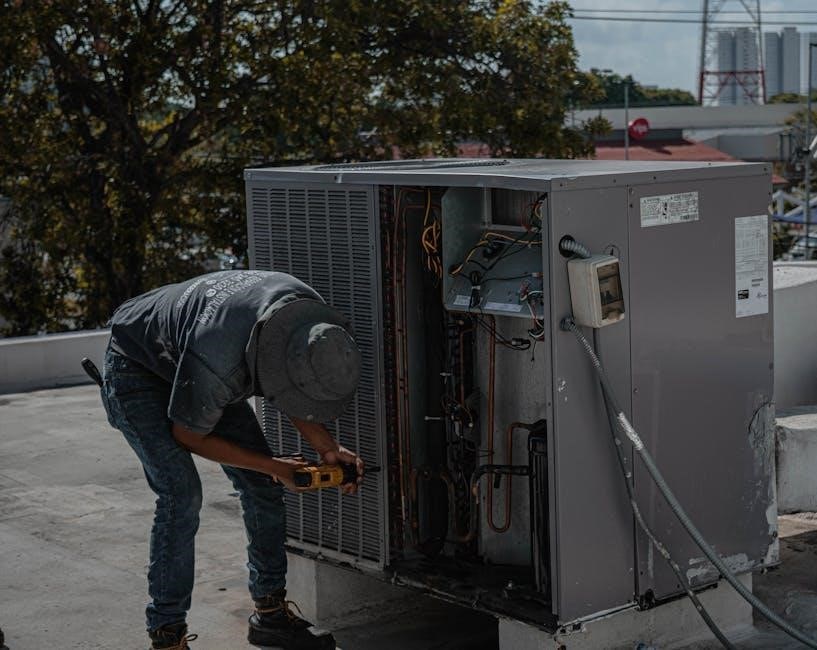What is a Manual Damper in HVAC?
A manual damper is a component in HVAC systems used to regulate airflow by manually adjusting a blade or valve within ducts, controlling air distribution and system performance․
Definition and Purpose
A manual damper in HVAC systems is a mechanical device installed in ducts to regulate airflow manually․ It consists of a blade or valve that can be adjusted by hand to control the amount of air passing through․ The primary purpose of a manual damper is to balance airflow, ensuring proper air distribution across different parts of the system․ It is often used to fine-tune air flow rates during system setup or maintenance․ Manual dampers are essential for maintaining efficiency, preventing overloading, and ensuring optimal performance in heating, cooling, and ventilation systems․ They are a cost-effective solution for precise airflow control, making them a critical component in both residential and commercial HVAC setups․

Types of Manual Dampers
Manual dampers are categorized into volume control dampers, balancing dampers, and fire/smoke dampers, each designed for specific functions like airflow regulation, system balancing, and fire safety in HVAC systems․
Volume Control Dampers
Volume control dampers are essential components in HVAC systems, designed to regulate airflow by adjusting the opening of their blades․ These dampers are typically installed in ducts and allow users to manually control the amount of air flowing through specific sections of the system․ They are commonly used in residential and commercial settings to balance airflow, ensuring consistent temperature distribution across different zones or rooms․ Constructed from durable materials like galvanized steel, they feature a simple yet effective design with a handle or lever for easy operation․ Their ability to minimize leakage and operate smoothly makes them a reliable choice for maintaining energy efficiency and system performance․ Regular maintenance ensures optimal functionality, while their corrosion-resistant properties extend their lifespan in various environments․ This makes volume control dampers a crucial tool for achieving precise airflow management in HVAC applications․
Balancing Dampers
Balancing dampers are manual dampers specifically designed to regulate and balance airflow within HVAC systems․ They are typically installed in duct branches to ensure even air distribution across different zones or rooms․ These dampers feature adjustable blades that can be set to restrict or allow airflow as needed․ Constructed from durable materials like galvanized steel, they are encased in a protective sleeve for added stability․ Balancing dampers are essential for maintaining system efficiency, as they prevent overcooling or overheating in specific areas․ They are often used during system commissioning to fine-tune airflow rates․ Their simple design and manual operation make them a cost-effective solution for achieving precise air balance in both residential and commercial HVAC setups, ensuring optimal comfort and energy efficiency․
Fire and Smoke Dampers
Fire and smoke dampers are specialized manual dampers designed to prevent the spread of fire and smoke through HVAC ducts․ These dampers are typically installed in fire-rated walls or partitions and are equipped with fusible links that melt during high temperatures, triggering the damper to close automatically․ While primarily designed for safety, they may also have manual controls for testing or maintenance․ Constructed with fire-resistant materials, they are crucial in maintaining fire safety standards in commercial and industrial buildings․ Their role is to compartmentalize fire and smoke, ensuring occupant safety and reducing property damage․ Regular testing and maintenance are essential to ensure their functionality during emergencies, making them a critical component of fire protection systems in HVAC applications․

Key Features of Manual Dampers
Manual dampers are designed with robust construction, corrosion-resistant materials, and low leakage rates․ They offer smooth operation, easy adjustment, and durability, making them ideal for precise airflow control in various HVAC applications․
Construction and Design
Manual dampers are typically constructed from durable materials such as galvanized steel or stainless steel, ensuring corrosion resistance and long-term reliability․ Their design often features a simple yet robust mechanism, including a single blade or multiple blades that rotate within a galvanized steel sleeve․ The blade edges are usually sealed to minimize air leakage, ensuring precise airflow control․ Some models include features like gasketed blades for enhanced performance․ The compact and lightweight design allows for easy installation in various HVAC duct configurations․ These dampers are built to withstand the rigors of continuous operation, making them a practical choice for both residential and commercial systems․ Their straightforward construction ensures ease of maintenance and adjustment, providing reliable airflow regulation in HVAC applications․
Operation and Adjustment
Manual dampers operate by using a handle or lever located outside the duct to adjust the position of internal blades, controlling airflow․ This system allows users to manually regulate air distribution, ensuring optimal system performance․ Adjustment is typically straightforward, with the handle turning to open or close the damper blades․ Some models feature locking mechanisms to maintain precise settings, preventing accidental changes․ The operation is quiet and smooth, requiring minimal effort․ Regular adjustments may be needed to maintain desired airflow levels․ Proper operation ensures energy efficiency and consistent indoor air quality․ Maintenance involves checking for dust buildup and ensuring blades move freely, keeping the damper functioning effectively․ This simple yet reliable mechanism makes manual dampers a cost-effective solution for airflow control in HVAC systems․

Applications of Manual Dampers in HVAC Systems
Manual dampers are widely used in both residential and commercial HVAC systems to control airflow, balance air distribution, and regulate temperature in various spaces, ensuring efficient system performance and comfort․
Residential HVAC Systems
In residential HVAC systems, manual dampers are essential for controlling airflow in ducts, ensuring even temperature distribution across rooms․ They are often installed near vents or junctions, allowing homeowners to adjust air flow manually․ These dampers are cost-effective and simple to operate, making them ideal for balancing air distribution in homes․ By regulating airflow, they help maintain consistent comfort levels and energy efficiency․ Manual dampers are particularly useful in zones with varying heating or cooling needs, providing flexibility without the need for advanced automation․ Their durability and ease of use make them a practical choice for residential applications, ensuring optimal performance of the HVAC system․ Internet sources highlight their popularity in home ventilation systems for precise air control and balancing․
Commercial HVAC Systems
In commercial HVAC systems, manual dampers play a crucial role in managing large-scale airflow requirements․ They are often used in duct networks to regulate air distribution across different zones or rooms, ensuring efficient heating and cooling․ These dampers are typically more robust than residential models, designed to handle higher airflow volumes and varying pressure conditions․ Manual dampers are commonly installed in main trunks or branch ducts, allowing facility managers to fine-tune airflow for optimal comfort and energy savings․ Their simplicity and reliability make them a preferred choice for balancing and controlling air flow in commercial environments, ensuring consistent indoor air quality and system performance․ Internet sources emphasize their importance in maintaining precise air regulation in industrial and office settings․

Installation and Maintenance
Manual dampers require precise installation to ensure proper airflow and system efficiency․ Regular maintenance involves cleaning and lubricating moving parts to maintain smooth operation and longevity․ Internet sources highlight the importance of proper installation techniques and routine checks to prevent leakage and ensure optimal performance in HVAC systems․
Best Practices for Installation
Proper installation of manual dampers is crucial for optimal HVAC system performance․ Ensure the damper is sized correctly for the duct to maintain airflow efficiency․ Install the damper in the correct orientation, as specified by the manufacturer, to prevent airflow restrictions․ Secure the damper tightly to the duct to avoid leakage and vibrations․ Align the control handle for easy access and precise adjustments․ Use appropriate sealing materials to prevent air leaks around the damper․ Follow the manufacturer’s instructions for mounting and connecting the damper to ensure reliability and longevity․ Proper installation practices help maintain system efficiency, reduce energy costs, and prolong the lifespan of the damper․
Regular Maintenance Requirements
Regular maintenance of manual dampers ensures optimal performance and longevity in HVAC systems․ Clean the damper blades and surrounding areas periodically to remove dust and debris that could obstruct airflow․ Inspect the damper’s moving parts, such as hinges and linkages, for wear or corrosion, and lubricate them if necessary․ Check for any blockages in the ducts near the damper that could restrict air movement․ Ensure the damper’s seal is tight to prevent air leakage when closed․ Additionally, verify that the control handle is securely attached and functioning smoothly․ Regular maintenance helps maintain precise airflow control, prevents system inefficiencies, and reduces the risk of mechanical failure over time․
